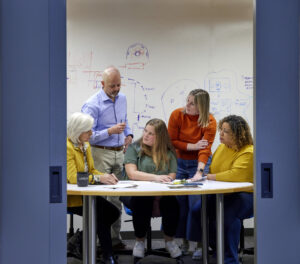Fabrication Designer, Raegan Maddox.
The first time that I hit ‘render’ and saw something that I had created not only exist in a 3-D environment but actually look like something that already exists in a photo-real sense, it was a remarkable moment.
Exploring buildable design via 3-D modeling brings a planned visitor experience to life for our clients in a way that drawings do not. Instead of having something described to you or looking at a plan or elevation view, you’re seeing your ideas brought to life in the world we want to create for you. You’re seeing perspective lines, the horizon, shadows, the materials used to make that world, all the details living in that world.
For Solid Light, it’s about exploring creative possibilities while also being efficient. We can see what design ideas might work and where the pitfalls are before we get into the fabrication phase when challenges in the physical world start to become too expensive and time-consuming to overcome. We can see where design ideas might fail before we spend a lot of manpower, time, machinery, and materials in trying to create that world.
Figuring Out Less is More
3-D modeling can be deceiving—a picture might be worth a thousand words, but it can also conceal many lies. Buildable design only works well if you have a good understanding of how to translate that 3-D environment into the real world.
A good example is a large story screen we created for a client. We started out with the idea of six monitors, but in putting that design in the 3-D world and placing a person next to it, we began to understand the weight of those monitors, the kind and size of steel structure necessary to suspend something weighing almost a ton from the ceiling. Through the 3-D modeling, we came to understand we could get to the place we wanted to go with four monitors, slightly larger in size.
Raegan’s Advice:
Always remember that what you see in a 3-D model is not final, even though it may appear that way. This is a process—the buildable design can be changed. At the end of the day, it’s your vision, your product, your space, your passion, and your story. Solid Light wants to get that right, no matter how long it takes.
Fabrication Designer Raegan Maddox has worked at Solid Light for two and a half years, coming from the Louisville Ballet and freelance work. When he’s not preparing buildable designs for clients, you might find him at home, designing his own projects on the computer, or enjoying central Kentucky scenery.




